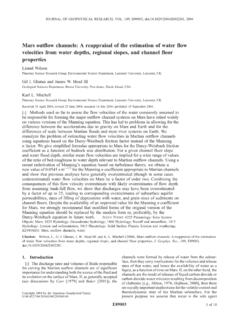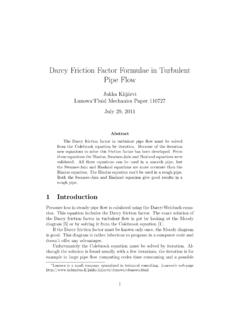Transcription of A REVIEW OF FRICTION FORMULAE IN OPEN CHANNEL …
1 International Water Technology Journal, IWTJ Vol. 5 , March 2015 43 A REVIEW OF FRICTION FORMULAE IN open CHANNEL FLOW Zidan, Abdel Razik Ahmed Prof. of Hydraulics, Faculty of Engineering, El Mansoura University E-mail: zidanara @ ABSTRACT Due to the lack of analytic representation of frictional resistance in open channels, the traditional Manning or Chezy equation for steady uniform flow is usually assumed to be suitable as well as a practical representation of frictional resistance expected for unsteady flow. No much attention has been given to any other frictional formula in application related to unsteady non-uniform flow or tidal phenomena in open channels and rivers. The purpose of this research is to demonstrate the application of alternative equations of resistance, such as the rough turbulent formula, the Williamson equation and the Colebrook White equation.
2 Differences between, and limitations of each formula are also presented. An approach to the solution of Colebrook White formula in an explicit form in open channels is given. A comparative study between this formula and other explicit FORMULAE is also highlighted. Received 13 Mar , April 2015 Presented in IWTC 18th 1 REVIEW The Chezy formula In 1768, Antoine Chezy (Rouse, 1957), an engineer of the French Bureau of Bridges and Streets was given the task of designing a canal for the Paris water supply. He reasoned that the resistance would vary with the wetted perimeter and with the square of velocity, and the force to balance this resistance would vary with the area of cross section and with the slope. Therefore, he reasoned that V2 P/(A S ) or V2/( R S) would be constant for any one CHANNEL and would be the same for any similar CHANNEL .
3 His manuscript was not published until 1897, but his method gradually became known, and the square root of the preceding ratio came to be known as the Chezy coefficient The formula can be written as: RSCV .. (1) where: V : velocity of water; C : Chezy's coefficient; R : hydraulic radius; and S : bed slope. The Manning Equation In 1891, another Frenchman, Flamant attributed wrongly to the Irishman that C varies with the sixth root of R, although Gauckler in 1868 had proposed the same International Water Technology Journal, IWTJ Vol. 5 , March 2015 44 hypothesis for flat slopes and also Hagen in 1881 attributed the same concept to any slope ( Rouse, 1957). nRC61 .. (2) from which SRnV321.
4 (3) where: n is the characteristics of the surface roughness alone and the unit of length used is meter. In 1911 Buckly converted this equation to the foot second unit as .. (4) This equation is known in the English speaking world as the Manning equation, although on the continent of Europe it is sometimes known as strickler's equation. The Manning equation has proved most reliable in practical and extremely popular in western countries In order to relate the Manning coefficient (n) and the equivalent particle size (k), Strickler's empirical formula (1923) was used as ( Henderson, 1966): k = ( n / )6 .. (5) in which (k) in feet The Williamson formula In 1951, James Williamson showed minor but reasonable adjustment to Nikuradse's results (Williamson, 1951) by correcting certain of Nikuradse's calculations and increasing the assumed grain sizes to allow for thickness of the varnish used to stick the grains, Figure (1), to the pipe wall.
5 He found that points representating Nikuradse's results fell mush closer than before to a straight line having slope 1:3. Further he plotted some more observations made by himself, Figure(1), based on his experience with three large concrete line aqueducts and another of smaller which came under his design and supervision in the Galloway water power scheme in Scotland. He found that they fell on a line having the same slope The Williamson formula is given by: dkF .. (6) (7) where: F : roughness coefficient; k : equivalent particle size; d : diameter of pipe; and R : hydraulic radius International Water Technology Journal, IWTJ Vol. 5 , March 2015 45 Figure 1. Correction of Nikuradse s data (Williamson, 1951) The Colebrook Equation L.
6 Prandtle and Von Karaman in Germany, and Tylor in expressing mathematical form the mechanism of turbulence linked the experimental investigation of Nikuradse (1932-1935) had proved a formula of the type (Colebrook, 1938): .. (8) and showed the lower limit of the integration y1, is a function of the wall particle size k, in the case of rough pipes in which the flow obeys the square resistance law, and is dependent on the density , the viscosity and the shear stress at the wall in the case of smooth pipes. In 1938, Cyril Frank Colebrook confirmed the substitution of values of y, in the foregoing equation and adopted the following resistance law (a) Flow in hydraulically smooth pipes: .. (9) (b) Flow in hydraulically rough pipes.
7 (10) And he mentioned that the results of Nikuradse show complete agreement with above two laws provided certain limiting conditions are satisfied. F F Log r/k F International Water Technology Journal, IWTJ Vol. 5 , March 2015 46 Transition Zones The following formula is used to classify the different types of flow, either smooth, transition or rough turbulent Rf = V*k/ where: V* : shear velocity; k : equivalent roughness height; and : kinematics viscosity. The roughness Reynolds number (Rf) may be expanded into: VRRkFkV8* .. (11) in which F is the resistance coefficient, V is the mean velocity and R is the hydraulic radius. This expansion is a product of three dimensionless numbers, the resistance coefficient, the relative roughness, and Reynolds number.
8 The limit of Rf for transition zones has been given by Colebrook (1938) in pipes from 3 to 60, Keulegen and Patterson (1943) has provided this limit in open channels from to 67. In order to remove any uncertainty, others have given the value of Rf for transition zone from 1 to 100. In this present study this value of Rf has been considered from 4 to 100 as given by Henderson (1970). A value of k equal to ft (n= ) exhibited substantial transition zones in the river Forth of Scotland for 32 hour tidal wave input. The transition zone occurred at different places along the river from Stirling to Rosyth. For k = ft (n = ) the transition zone has a negligible influence. A value of computed Reynolds number for transition zones in the river Forth of Scotland varied between 103 and 107 where the maximum Reynolds number was *108 for rough turbulent flow conditions (Zidan, 1978).
9 An attempt to express mathematically the transition function for uniform sand roughness is rendered difficulty owing to the fact that the turbulent motion in the Wake behind the grain is complicated by the mutual interference, and the resistance mechanism made up of viscous and mechanical force which are difficult to separate. The exact distribution of the function will depend on the distribution of the roughness elements and it is mathematically indeterminate. 2 COLEBROOK- WHITE EQUATION Implicit Colebrook-White Formula A suggestion by White for transition formula which similar to those obtained experimentally for commercial pipes, was simply add together the lower limits of integration y, which satisfy the rough and smooth pipe laws, providing the general formula For transition regime in which the FRICTION factor varies with both Re and k/d , the equation universally adopted is due to Colebrook and White (1937) as: International Water Technology Journal, IWTJ Vol.
10 5 , March 2015 47 .. (12) where: F : roughness coefficient; k : equivalent particle size; d : diameter of pipe; and Re : Reynolds number The Colebrook equation is transcendent and thus can not be solved in terms of elementary function. Some explicit approximate solutions have been proposed such as: Explicit Colebrook-White FORMULAE The implicit nature of Colebrook White function (9) has sometimes acted against its adoption in preference to other FRICTION FORMULAE . In 1938 White gave an approximation to the logarithmic smooth turbulent element in the Colebrook White equation which was compatible in form with the original one. If Reynolds number is raised to an index could be accepted as a substitute for ReF in equation (9), then: .. (13) or (14) Barr Formula (1972).









